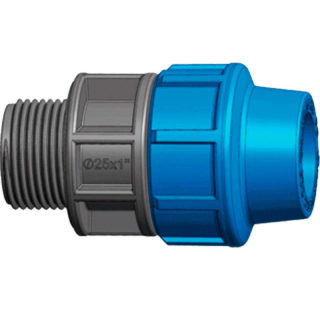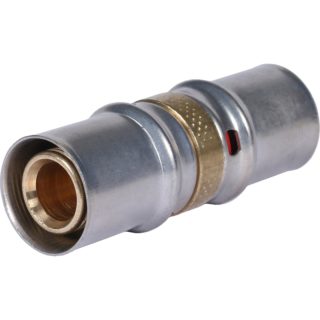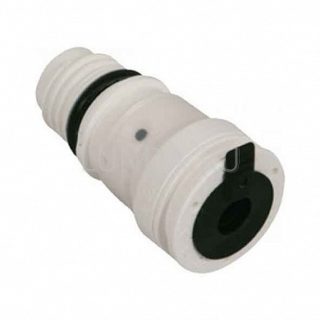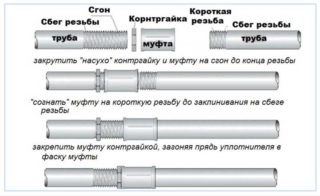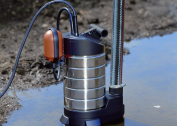To connect PVC, PET or polypropylene pipes, plumbers use plastic couplings for plumbing. Similar elements are also made of metal. Select the type of fitting depending on the situation, based on the specific technical parameters of the pipeline.
Definition and purpose of the water connection
A sleeve is a special fitting designed to tightly connect two elements of a pipeline. The inner section corresponds to the outer diameter of the connected tubes. It is important to choose a fitting from the same material as the communication pipes.
Couplings are mainly used when installing various engineering networks or when installing a pump on them. Fittings are widely used in the following areas:
- installation of water, gas, oil pipelines;
- building sector;
- all types of industries: pharmaceutical, chemical, food, metallurgical, etc.
In private construction, plastic repair couplings for a water pipe are mainly used. All fittings are manufactured strictly according to GOST, since they are subject to increased requirements for strength and tightness.
Types of Fittings
All couplings are divided into groups according to the material of manufacture and method of installation. In the first case, the following elements are distinguished:
- metal: steel, cast iron, brass, bronze;
- polymer: metal-plastic, PVC, PVC-U, polypropylene, low-pressure polyethylene.
Without exception, all fittings are in the form of a short pipe, worn over the main parts of engineering communications. Two opposite pipe sections are inserted into the fitting until they stop. The clamped coupling holds them securely.
Elements are divided into groups according to the installation method:
- Threaded. They have an internal thread on both ends. Connect the fitting to the pipe by screwing on. Most often, such elements are used for a metal pipeline.
- Crimp. Mainly applicable for the installation of PVC water pipes.
- Welded. They are installed by special welding (soldering). They are most often used when laying underground networks made of PET (polyethylene communications).
- Compression. Mounted without the use of special equipment.
Special push-clutches are also available on the market, which are mounted within 1-2 seconds. Simply connect the pipe by inserting it into the fitting until it clicks.
The main criteria for choosing water couplings
Before buying a connecting element, it is important to consider the following parameters:
- Diameter. The inner cross-section of the coupling must fully match the outer diameter of the pipe. Otherwise, the fitting will either not fit on it or will hang. In neither case, there can be no talk about the tightness of the network.
- Coupling length. This parameter is especially important when installing the pipeline on a limited area. A fitting may simply not enter a designated niche.
- The material of manufacture. It is important to select the coupling exactly from the same pipe. This ensures the optimum compliance of the engineering network with the declared characteristics of the material.
- Intended use of a specific pipeline section. If it is supposed to carry out additional repair work or install branches, it is rational to mount a threaded (collapsible) coupling. It can be removed later.
If you doubt the correct choice, a consultant at the outlet will always help. It is only important to know the main parameters of your water supply - the material for the manufacture of pipes and their diameter.
Coupling installation principles depending on the type of connection
Each type of fitting has its own installation technique. It is important to observe it strictly, otherwise the tightness of the pipeline will suffer.
The threaded couplings are installed in this way:
- The water in the riser is blocked to avoid an emergency.
- The pipe is cut in the intended place strictly perpendicular to its axis. If you neglect this, the ends of the tube may not converge later in the coupling.
- A thread is cut into each part of the disassembled pipe.
- Then, on both sides, the master puts on the compression nuts. With their help, the connection will be more tight.
- Screw both ends of the pipe into the sleeve from two sides.
- The last step is to tighten the nuts. They must snug against the walls of the coupling.
Welding is used when installing the PP fitting. A coupling for connecting polypropylene water pipes is installed in this way:
- The pipe is cut in half at the intended location.
- The edges are deburred inside and out.
- A special soldering iron with nozzles is heated to the desired temperature.
- The wizard inserts the sleeve and pipe section into their respective connectors. Here the polymer softens when exposed to high temperatures.
- After 10-12 seconds, you can insert a segment of the tube into the sleeve and drive it all the way.
- The cooled polypropylene forms a tight tight connection.
Bonding is used when installing PVC fittings. In contrast to exposing the polymer to high temperatures, special glue is used here. Its aggressive composition somewhat softens the polyvinyl chloride, resulting in adhesion of the material. Work is performed in the following sequence:
- The water pipe is cut in the intended place.
- One end of it is inserted into the sleeve and the place of the stop is marked with a pencil.
- The segment is taken out and spread along its surface to the intended line with special glue.
- The prepared pipe is inserted into the fitting and turned a quarter of a turn for a good distribution of the adhesive.
- Already after 1-3 minutes in a similar way you can connect the second piece of PVC pipe to the sleeve.
Electric welding: use special PND fittings with spirals built into them. The installation process looks like this:
- A clutch is put on the prepared parts of the network.
- A device is connected to the fitting, which is powered by electricity and feeds it into spirals.
- As a result of such exposure, the latter heat up and melt the HDPE. Welding of the elements of the pipeline.
Installation of the compression sleeve is carried out in the following sequence:
- Prepare the two ends of the tube, cleaning them from dirt and burrs.
- All the elements of the compression fitting are put on the pipe: collet ring, nut, etc.
- The prepared length of the water supply is inserted into the coupling pipe or put on the fitting.
- The collet ring approaches and the nut tightens.
It is not recommended to tighten the nuts to the limit, especially on polymer pipelines. Excessive force can cause a crack in the system.
Crimp: the wizard prepares two edges of the pipe and inserts them into the fitting. The junction of the sleeve is crimped with a special device. It ensures tight coupling of the coupling with the pipe.
Whatever type of plumbing fitting is chosen, it is important to connect all parts without rush and in series. The strength of the joint and the tightness of the system as a whole depend on this. Violation of installation technology can provoke an emergency situation on the riser.
